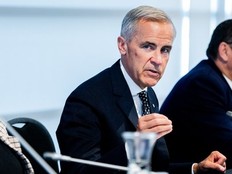GOLDSTEIN: What happened to Mark Carney’s art of the deal?
Since becoming prime minister, his strategy for dealing with Donald Trump has been mostly one of appeasement rather than confrontation

Article content
Prime Minister Mark Carney was elected because he said he was the best leader to deal with Donald Trump in a tariff war.
Now would be a good time for him to prove it.
When he was running for the Liberal leadership, Carney’s approach to dealing with the U.S. President was all “elbows up” rhetoric.
In January, he said Trump’s threat of imposing an illegal 25% tariff on Canadian imports was “a blatant violation of our trade agreements, and will demand the most serious trade response in our history …
“Dollar-for-dollar retaliatory tariffs by Canada should be a given and they should be aimed where their impacts in the United States will be felt the hardest.”
But as prime minister, Carney’s strategy for dealing with Trump has been mostly one of appeasement rather than confrontation.
The question, given Trump suspending all trade and security negotiations with Canada on Friday because of U.S. anger over Canada’s digital services tax, which has been widely criticized by business groups in Canada and the U.S., is whether Carney’s strategy is working.
(The digital services tax was passed a year ago by the Justin Trudeau government and is poised to extract billions of dollars in tax revenue from a number of U.S. tech giants operating in Canada, starting Monday.)
In March, Carey abandoned “dollar for dollar” tariffs, saying it was unrealistic given that the U.S. economy is ten times the size of Canada’s.
While Carney has imposed selective tariffs on U.S. goods in response to Trump’s tariffs on Canadian goods, in April he removed some Canadian counter-tariffs on automakers as long as they maintained production and investment levels in Canada.
He also announced the suspension of counter-tariffs for six months on goods imported from the U.S. used in Canadian manufacturing, processing and food and beverage packaging, as well as on goods used to support public health, health care, public safety and national security.
In June, the Carney government introduced the “Strong Borders Act” to “keep our borders secure, combat transnational organized crime, stop the flow of illegal fentanyl, and crack down on money laundering” in deference to Trump’s demands about border security.
Also in June, Carney announced Canada would meet its long-neglected NATO target of spending 2% of annual GDP on defence by March 31, 2026, another Trump demand.
RECOMMENDED VIDEO
Last week, Carney said Canada would comply with Trump’s demand to increase spending on defence to 5% of GDP by 2035, carrying a $150-billion a year price tag.
The Carney government didn’t respond to Trump’s decision earlier this month to double U.S. tariffs on steel and aluminum to 50%.
He called them “unlawful, unjustified and illogical” and said Canada was preparing a response but would hold off imposing counter-tariffs pending the outcome of ongoing negotiations between Canada and the U.S.
(Since then, the federal government has announced tariff-rate quotas on steel mill products imported into Canada but the Canadian steel industry has called them insufficient.)
On June 16, following a meeting with Trump at the G7, Carney announced Canada and the U.S. had agreed to a 30-day deadline to reach a deal on trade and security.
While Trump suggested a deal was possible, the announcement of the deadline – subsequently set at July 21 – came only from Carney.
As the Prime Minister’s Office described it:
“Prime Minister Carney and President Trump discussed immediate trade pressures and priorities for each country’s workers and businesses, and shared updates on key issues raised in negotiations on a new economic and security relationship between Canada and the U.S.
“To that end, the leaders agreed to pursue negotiations toward a deal within the coming 30 days.”
RECOMMENDED VIDEO
But within a week, Carney was downplaying that announcement, saying there was no assurance a deal would be reached by July 21. And on Friday, Trump suspended all negotiations because of the digital services tax.
It may be that there is no effective strategy – either confrontation or appeasement – to deal with Trump given the size of the U.S. economy compared to ours and the fact Trump thinks nothing of breaking existing trade agreements while demanding new ones and changes his positions on issues within days of making them.
His negotiating style is to make enormous demands, then delay their implementation to see how much he can get, with the threat he will cause economic chaos if negotiations fail.
That said, Carney told Canadians he could handle Trump.
So far, the jury is out.














Postmedia is committed to maintaining a lively but civil forum for discussion. Please keep comments relevant and respectful. Comments may take up to an hour to appear on the site. You will receive an email if there is a reply to your comment, an update to a thread you follow or if a user you follow comments. Visit our Community Guidelines for more information.